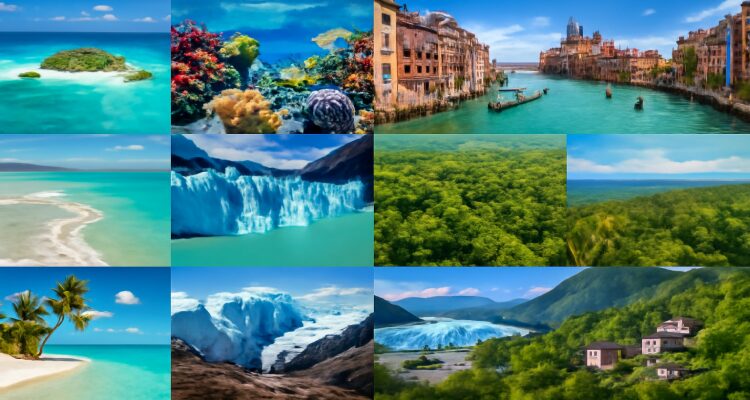Vanishing Destinations: 10 Places You Must See Before They Disappear
From coral reefs to ancient cities, climate change and human impact are putting the world’s treasures at risk. Explore 10 destinations to see before they vanish.
Introduction: A Race Against Time
Travel has always promised discovery, wonder, and connection. But today, it increasingly carries another element—urgency. Some of the planet’s most breathtaking destinations are slipping away faster than we can protect them. Rising seas, melting glaciers, unchecked tourism, and environmental degradation are erasing places that have stood for centuries. For travelers, these sites are more than just stunning backdrops; they are living pieces of human history and natural heritage at risk of fading into memory.
Context & Background: Why the World Is Losing Landmarks
Climate scientists warn that global temperatures are rising at unprecedented rates, accelerating processes like polar ice melt, coral bleaching, desertification, and coastal erosion. Meanwhile, growing tourism pressures, pollution, and political instability add further risks. According to UNESCO, nearly half of all World Heritage sites are under threat from climate change. The phenomenon isn’t a future possibility—it’s unfolding now.
Below are ten remarkable destinations you may want to witness before they’re gone.
Main Developments: The 10 Places Disappearing Fast
1. The Maldives – Paradise Sinking Beneath the Waves
This Indian Ocean nation, made up of over 1,000 islands, could be uninhabitable within a century due to rising seas. Its pristine beaches and coral reefs draw millions annually, but heightened sea levels may soon swallow coastal settlements.
Image Alt Text: Aerial view of Maldives islands surrounded by turquoise water
2. Great Barrier Reef, Australia – A Coral Giant in Crisis
Once visible from space as the world’s largest living structure, the Great Barrier Reef has suffered massive bleaching events. Warming seas threaten its biodiversity, potentially turning the vibrant ecosystem into a barren underwater graveyard.
Image Alt Text: Scuba diver swimming among coral reefs of Great Barrier Reef
3. Venice, Italy – The Floating City Slowly Sinking
Venice has always been synonymous with water. But frequent flooding, sea level rise, and crumbling infrastructure put its existence in jeopardy. Despite advanced flood barriers, residents fear their city will become unlivable within decades.
4. The Dead Sea – Shrinking into Salt Pits
Bordering Jordan and Israel, the iconic lake has been receding at alarming rates. Human water diversion and climatic changes cause sinkholes to form around its basin, turning once-thriving spa coastlines into deserted wastelands.
5. Patagonia’s Glaciers, Argentina & Chile – Ice Disappearing Fast
Glaciers in Patagonia—massive and awe-inspiring—are retreating rapidly. With global warming accelerating ice loss, tourists are racing against time to witness these frozen giants crack, shift, and dissolve.
6. Amazon Rainforest, South America – The Lungs of the Earth Burning
Deforestation, fires, and exploitation threaten the largest rainforest on Earth. The Amazon plays a critical role in regulating the global climate, yet vast portions are being destroyed for agriculture and logging.
7. Tuvalu – A Nation on the Brink
This Pacific island country has become the symbol of climate displacement. With land disappearing and freshwater scarce, Tuvalu risks being swallowed by the ocean, raising questions of sovereignty and national identity.
8. Mount Kilimanjaro’s Glaciers, Tanzania – Africa’s Frozen Crown Melting Away
The snows of Kilimanjaro, immortalized in literature and culture, may vanish within a few decades. Scientists estimate that up to 80% of its ice cap has already disappeared.
9. The Everglades, Florida, USA – Wetlands Under Siege
Saltwater intrusion, invasive species, and urban sprawl threaten this UNESCO World Heritage Site. Once one of the most biodiverse wetlands on Earth, the Everglades are shrinking and losing species at alarming rates.
10. Bhutan’s Himalayan Villages – At Risk from Glacial Lake Outbursts
High in the Himalayas, Bhutan’s communities face hazards from melting glaciers forming unstable lakes. Sudden outburst floods could devastate entire valleys, erasing centuries-old cultural heritage.
Expert Insight & Public Reaction
“Climate change isn’t an abstract concept—it’s happening before our eyes, destroying places that are irreplaceable,” says Dr. Elena Márquez, an environmental geographer. According to a recent IPCC report, rising global temperatures will continue to displace both ecosystems and human communities.
Meanwhile, social media is filled with travelers documenting their visits to these fragile sites under hashtags like **#LastChanceTourismrawing concern from conservationists who caution against unsustainable travel that may accelerate damage.
Impact & Implications
The disappearance of these destinations is more than a loss for tourism. It carries profound implications:
-
Economic Collapse: Communities dependent on tourism face declining livelihoods.
-
Cultural Destruction: Ancient traditions and civilizations tied to physical landscapes risk oblivion.
-
Biodiversity Loss: Extinction rates rise as natural habitats vanish.
-
Climate Refugees: Entire nations, like Tuvalu and the Maldives, may see citizens displaced globally.
This reality is pushing policymakers, environmental organizations, and local communities to find solutions—from sustainable tourism practices to large-scale international climate agreements.
Conclusion: Seeing Responsibly, Preserving Deeply
The allure of these disappearing destinations lies not just in their beauty but in their fragility. Experiencing them is an act of appreciation—but also one of responsibility. Travelers are urged to engage in ethical tourism, reduce environmental footprints, and support conservation efforts.
One thing is clear: our collective actions in the coming years will determine whether future generations inherit a world of living wonders or stories about what once was. If you plan to visit these destinations, let your journey go beyond sightseeing—let it become part of the solution.
Disclaimer:This article is for informational purposes only. Travelers should research current conditions and prioritize sustainable practices when visiting fragile environments.











